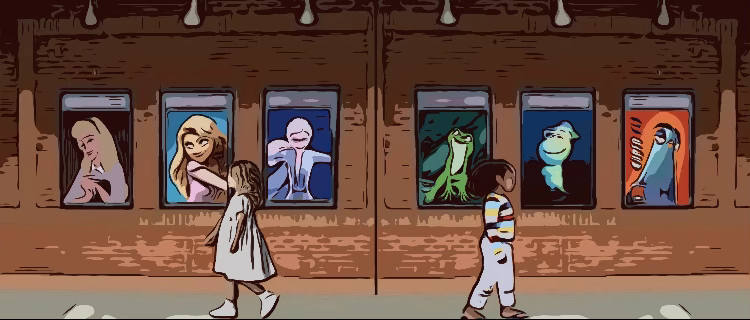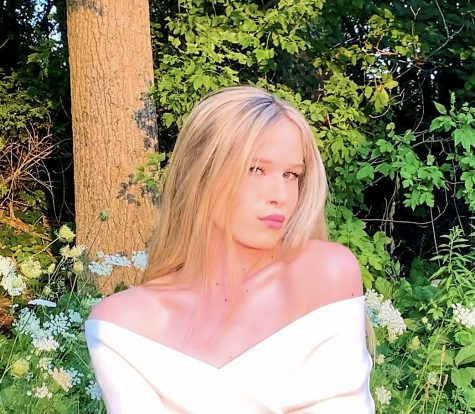Drawing the line: “diversity” in animation borders on racism

Growing up, nothing was better than an animated classic: a simple film with good morals, fun moments, bright colors, immersive worlds, and characters you could relate to. Wonderful adventures all wrapped up in 90 minutes or less you could watch it again and again.
My internal conflicts growing up couldn’t exactly be solved 90 minutes, and I didn’t have characters I could relate to. The overall purpose of animated films is to entertain and immerse yourself in their storytelling. While I didn’t feel represented, I was certainly immersed, escaping my gender the best I could.
Growing up a little boy who was truly a little girl along, my story was still waiting to be told. I just wasn’t ready to press play. Despite that, I was still privileged to see exactly who I wanted to be regularly represented in film. Everywhere I looked, I saw white and blonde Disney princesses who didn’t look like me, but who felt like who I was supposed to be.
Back then, I didn’t realize that children of color experiencing my same internal conflict didn’t have my same ability to escape my personal struggle. It wasn’t until later in my story that I realized animation is strictly catered to white people.

It was June of 2019, and Pixar announced their upcoming feature films.
As a longtime devotee to animated films, the picture that caught my eye wasn’t Onward, with its promise of a fantasy adventure featuring blue elves and their dead father’s pair of legs. Instead, it was the film that, following twenty-one films with little to no representation, would feature the company’s first ever Black lead: Soul.
Soul was poised to follow the adventures of a Black male musician who was a middle school band director by day and a budding professional jazz musician by night. I was hooked immediately, ecstatic at the announcement, and clicked as swiftly as my fingers could move when the first trailer dropped.
My excitement dwindled when I realized the title Soul wasn’t named after his journey with soul music, but his journey in the afterlife. Viewers see the main character, Joe, thrilled that he got the gig of his dreams, but then the trailer ends with him crossing the street to his demise. It isn’t even a somber moment: his death is the final gag laugh of the trailer. One minute he is living his dream, and then poof, he falls down a sewage manhole.
Afterward, he emerges as a green blob of energy, now a proper Soul on the bridge to the final resting place, dead on arrival right as he was reaching his dreams.
And just like that, what could have been a brilliant chance for Pixar to take a step toward diversity turns into a tale of poorly poetic irony: their first ever Black main character isn’t just killed off at some point in the movie, he meets his demise in the trailer.
Certainly this film was put into production long before the murder of George Floyd, Breonna Taylor, and a very long list of many more victims of police brutality and systematic racism, but the weight of this choice by Pixar still remains, no matter how innocuous the intent. They released their first ever feature film featuring a Black main character in 2020, and he’s killed in a laughing moment in the first ten minutes and then spends the rest of the movie not Black, but blue, and then eventually not even in human form, but as a cat.
I was deeply disappointed, because I had seen this all before.
Animation has had a long and poor track record with legitimate visibility for any characters of color. In Disney Animation’s 2009 Princess and the Frog, Princess Tiana’s dreams of opening a restaurant as a Black female business owner in 1920’s New Orleans are sidetracked because she kissed a frog, causing her to spend over half the film as a frog herself. Princess Tiana is also the only of twelve disney princesses to not be born of wealth and royalty. Obviously her storyline revolves her rising above her homelife and reaching her goal of her own restaurant. If she was born into wealth and royalty, it would simply be too easy for her. Although Tiana seems more grounded than the other princesses, it comes at the cost of her having to climb even farther to stand amongst royalty and other princesses born of privilege. Almost indirectly saying Tiana with her melanin and curls wasn’t good enough to be born into royalty. At the time, the film was celebrated for its diversity, but the truth wasn’t that it deserved the accolade because of it’s introduction of the long-awaited Black Disney princess, but rather that representation had been so sparse before that the fact that she only spent 42% of her screen time as a Black woman felt like a victory.
This trend continued with 2019’s Spies in Disguise, 20th Century Fox’s animated film which followed a Black Bond-like character that exudes all things cool until he was transformed into a pigeon early in the film. Initially, this seemed to be a large feat for visibility with an awesome character for children to look up to on all his spy adventures. Only his becoming a pigeon diminished the weight and impact of the film’s Black lead character, especially considering that the white teenage scientist that accidentally turned him into an animal in the first place got far more screen time than the main character of color himself.
I know that visibility is necessary in any film, but especially when it comes to children’s film. These films shape a child’s entire outlook on the world, because they shaped mine. I believed for a long time the best disney princesses were the white and blonde ones, because that was all I saw and all I wanted to be. Unaware that I could look up to any princess of every ethnicity or story. My experience is taken to the next level for children of color. If they only ever see white main characters in every story, film, show, or any form of media, they begin to see themselves apart from the stories broadcasted all around them. This has been a longtime reality, reflected in the unfortunate results of the 1940’s doll experiment, in which Black children in the study chose white dolls over dolls that looked like them, seeing their darker skin color as inferior to that of the white dolls they chose. This same scenario, where Black children are socially conditioned to internalize ideas that they are somehow less valuable, is being played out sixty years later in mainstream media. White or lighter skinned children see themselves projected in every aspect of the world around them, and their future feels boundless as a result because they can see unlimited opportunities for people that look like them. That simply is not the case for Black children, whose cinematic existence is relegated to living as an amphibian, bird, or soul for a vast majority of the film. Indirectly saying that characters that look like them are only interesting if transformed into something that isn’t their melanin.
Soul, for the most part, didn’t fall as hard as it’s predecessors. It has redeeming moments: the film follows Joe’s journey to rediscovering his soul and his dreams of soul music featuring a wide cast of diverse supporting characters that offer heaps of visibility and great storytelling. Pivotal moments featuring Joe’s local barber, his mother’s tailor shop, and auditioning for his dream gig with a famed musician of color Joe looks up to all provide positive representations of Black American culture.
Despite this, the film walks a fine line, particularly late in the film the problems emerge. A desperate Joe ends up accidentally swapping places with another soul (voiced by Tina Fey), leaving her white persona in Joe’s black body and Joe’s black persona in a therapy cat. The “walk in each other’s shoes” is ultimately therapeutic for them both, but the mere idea of a white soul living a day in a Black man’s body just doesn’t sit well with me. The body switch trope is well-established in film, but in this case, it’s repercussions when societal disparity and systematic racism come into play make it not just a fun switcheroo anymore. Although the film is rooted in clear fiction, the idea that they intentionally chose to have a presumably white character walk in a Black man’s shoes without at all demonstrating the difficulties a Black man faces on a daily basis in a systematically racist society seems not just a faux pas, but an act of legitimate ignorance. Soul doesn’t even touch on the social justice issues that Joe would face on a daily basis as a Black man living in America, and it’s disappointing that these nuances are entirely overlooked.
After dissecting these films for all they are, it’s important to know despite the flaws and the potential underlying racism at play, these movies still mean something to people. Even if sparse, they portray some inspiring and wonderful characters of color that deserved far more screen time as themselves, melanin and all. I just hope that going forward, film studios more fully comprehend the importance of diverse storytelling, understanding and accepting the responsibility that comes along with it. I wish I had more diverse stories growing up, I would have known earlier on that role models are not restricted to race. I can’t even comprehend how my life would have been changed if I saw a character with the same gender struggles as me. While seeking to tell more diverse stories, we must remember it is a complete disservice to tell said stories without acknowledging the complexity of their existence. They must be given the prominence and fullness in lead characters that they deserve. Above all else, it is imperative to never forget the following, despite what the films portrayed.
Black women are not frogs.
The death of Black men is never funny.
Black excellence is never too much.
Characters of color don’t need to be transformed to tell captivating stories.
Diverse storytelling can only be told by diverse voices.

Senior Kylie Clifton is in her fourth year as a NL staff member. She is a co-editor in chief, having previously served the NL as both a business manager...





Miles Slocum • Feb 17, 2021 at 10:13 am
This article was written so well and about such an interesting and unique topic, great job.
Ari Coleman • Feb 17, 2021 at 10:07 am
I totally agree with you, Kylie. A lot of us grow up on white Disney princesses and think that’s a princess but it’s not. Princess and the Frog were definitely an eye-opener to the whole Disney princess franchise. There definitely needs to be more diversity and help ALL to relate. Thank you for sharing this piece! Very Well done!
Lizzie Sheldon • Feb 15, 2021 at 12:14 pm
I completely agree Kylie. Many of us have grown up watching these animated movies and for me personally, my favorite animated movie is Princess and the Frog. I love Tiana’s strong, hard-working attitude and I’ve always wished that we would’ve seen Tiana more as a human rather than a frog. I’ve always questioned why the other Disney princesses who are white got to remain human, but the moment a black Disney princess is introduced, she is subjected to go through a journey of self discovery as a frog. I think it’s unfair. Thank you for talking about this because there needs to be more diverse representation!
Cerena Read • Feb 15, 2021 at 11:58 am
this gives me an entirely different outlook on disney movies and how they impact children watching. I have always been in love with any animated disney movie (excluding pocahontas), I always saw the huge imbalance of characters of color to white characters, but i never realized until i read your article how the impact of what they do in the movies featuring black characters is felt. My favorite movie is the princess and the frog, it always has been since i watched it for the first time, but i never realized how the changing of the main black character tiana impacted black children watching. they were represented, but not exactly seen, as tiana was turned into a frog for most of the movie. I always looked up to tiana’s character and the movie as a whole and i will continue to do so but in a new light, thank you for showing me this light and writing this for everyone out there to read. I just hope this reaches more people because you brought up a huge topic that needs to be addressed on a bigger scale. you’re amazing kylie, keep up the great work!
Meaghan Anderson • Feb 15, 2021 at 11:56 am
“…not black, but blue.”
“dead on arrival right as he was reaching his dreams.”
Kylie, this piece really blew me away. Such a poignant piece, and one that is really well assembled. Your message is clear, and your word choices are as poetic as they are socially important. As humans, it is easy to absorb media, absorb characters, take part in movements, but not take part in the moment.
How often do we see these strong BIPOC characters shining in movies and other popular media not Black…but blue? How often are these characters defined by suffering, violence and pain? Diverse story lines for white characters exist, and in fact the situations these characters find themselves in, much like the movie Onward, showcase that. But the same cannot be said for Black characters and other characters of color. Apparently the diversity of their skin color is enough for the creators, only so much room for diversity in media, right? Look at Coco. A Disney movie, based on a Mexican character, and what do the writers explore with this moment? Coco wants to be a musician. While culture is explored in the movie, much like Soul, the ending leaves much to be desired for the type of writing that could produce a worthwhile story.
In our current time, we see so many Black voices lifted..after their story ends. We see so many BIPOC d.o.a. right as they reach their dreams. Your assessment of this problem, your personal touches bringing your recognition of the issue at hand and really thoroughly examining the problem are all very much appreciated, Kylie. You have contributed something remarkable here, and I think it adds another facet to the problems we are struggling to address as a society right now. Thank you for this piece.
Olivia Coughlin • Feb 15, 2021 at 11:54 am
Kylie – I am usually astonished at your writing, and this one is no different. Going into this piece, I already had an idea of what was going to be said. And while you did touch on several of my pre-conceived points, you expanded on these ideas more than I would’ve ever thought to. I’ve never actually realized the importance of equal representation in childrens’ films, and this article brought that into light. With no representation in things like the media, movies, or books, young children can have an extremely warped internalization of themselves. Thank you for bringing this to our attention. 🙂
Kai Pennington • Feb 15, 2021 at 11:53 am
I have never looked more into films with main characters of color more than after reading this article. I can completely agree with Kylie’s finishing statements of “Black women are not frogs. The death of Black men is never funny. Black excellence is never too much. Characters of color don’t need to be transformed to tell captivating stories. Diverse storytelling can only be told by diverse voices.”
Katie Knight • Feb 15, 2021 at 11:50 am
I really liked this article, because I enjoy film analysis and often think about the ways film can shape our perception of the world. Great job!
Astrid • Feb 15, 2021 at 11:48 am
This is such an important topic for an article and something that has been bothering me for a long time. It’s as if animations can’t feature a Black main character without them transforming into something else for a large part of the movie. You really went in depth of this topic and I loved your examples. My only comment would be that the personal elements of this story connecting it to you might not have been necessary for this article.
Sloan M • Feb 15, 2021 at 11:46 am
Wow. This was such a powerful and moving article while being so well backed by facts. This was a tremendously important article. AMAZING WORK KYLIE!
Jackson Barnard • Feb 15, 2021 at 11:45 am
I like how you found a way to relate your own personal experiences to a big societal problem. You also spoke freely and truly stated your opinion on this topic which is brave of you considering how divided our world is today.
Chloe Clarke • Feb 15, 2021 at 11:42 am
I LOVE THIS!! I think it brings out a lot of important information and shows how biased the film industry is.